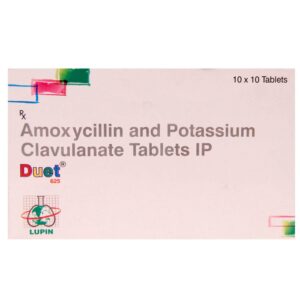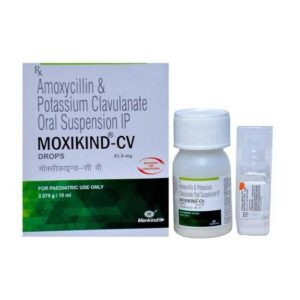AMOXYCILLIN + POTASSIUMCLAVULANATE
Amoxycillin: Amoxicillin is a commonly prescribed antibiotic medication used to treat a wide range of bacterial infections. It belongs to the class of drugs known as penicillins.
Mechanism of Action:
Amoxicillin works by inhibiting the synthesis of the bacterial cell wall, leading to cell death. It does this by interfering with the process of transpeptidation, which is vital for the formation of the bacterial cell wall. By disrupting this process, amoxicillin effectively kills susceptible bacteria and prevents their growth.
Use:
Amoxicillin is commonly prescribed for various infections including respiratory tract infections, ear infections, urinary tract infections, skin infections, and dental infections. It is also used as a part of combination therapy for the treatment of Helicobacter pylori infection in peptic ulcers.
Dosage:
The dosage of amoxicillin can vary depending on the specific infection being treated, the patient’s age, weight, and overall health. It is usually taken orally, either as immediate-release tablets or capsules. The dosage and duration of treatment will be determined by the prescribing healthcare professional and should be followed as directed.
Side Effects:
While amoxicillin is generally well-tolerated, it can cause some side effects. Common side effects may include gastrointestinal disturbances such as diarrhea, nausea, vomiting, and abdominal pain. Other less common side effects may include rash, allergic reactions, headache, dizziness, and yeast infections. It is important to inform a healthcare professional if any side effects are severe or persistent.
Rarely, amoxicillin can cause more serious side effects such as severe allergic reactions, liver problems, and a severe form of diarrhea called pseudomembranous colitis. If any signs of an allergic reaction (such as rash, itching, swelling, or difficulty breathing) or severe side effects occur, immediate medical attention should be sought.
It is worth mentioning that allergic reactions to amoxicillin can occur, particularly in individuals with a known allergy to penicillins or cephalosporins. If a person has a history of allergies, it is crucial to inform their healthcare professional before starting amoxicillin or any other medication.
Potassiumclavulanate: Potassium clavulanate is a combination drug that contains the active ingredient clavulanic acid, which is a beta-lactamase inhibitor. It is typically used in combination with certain antibiotics, such as amoxicillin, to enhance their effectiveness against bacteria that produce beta-lactamase enzymes.
The mechanism of action of potassium clavulanate involves inhibiting the activity of beta-lactamase enzymes produced by bacteria. Beta-lactamase enzymes are responsible for breaking down the beta-lactam ring structure found in antibiotics like amoxicillin, making them ineffective against certain bacteria. By inhibiting these enzymes, potassium clavulanate allows the antibiotic to remain active and effectively kill the bacteria.
The dose of potassium clavulanate may vary depending on the specific formulation and the condition being treated. It is available in different strengths and forms, such as tablets, oral suspension, and intravenous injection. The dose is usually determined by the prescribing healthcare professional based on the individual patient’s age, weight, and the severity of the infection.
Some common side effects of potassium clavulanate include diarrhea, nausea, vomiting, abdominal pain, skin rash, and allergic reactions. It may also cause liver problems in rare cases. If any severe or persistent side effects occur, it is important to seek medical attention.
It is essential to follow the prescribed dose and duration of treatment with potassium clavulanate to ensure its effectiveness and minimize the risk of antibiotic resistance. It is also important to inform the healthcare provider about any other medications or medical conditions a person may have before starting treatment with potassium clavulanate.


